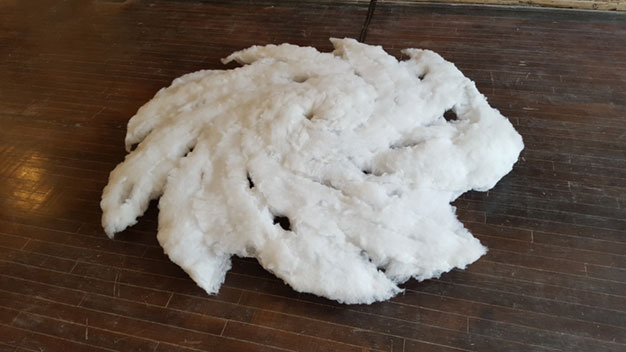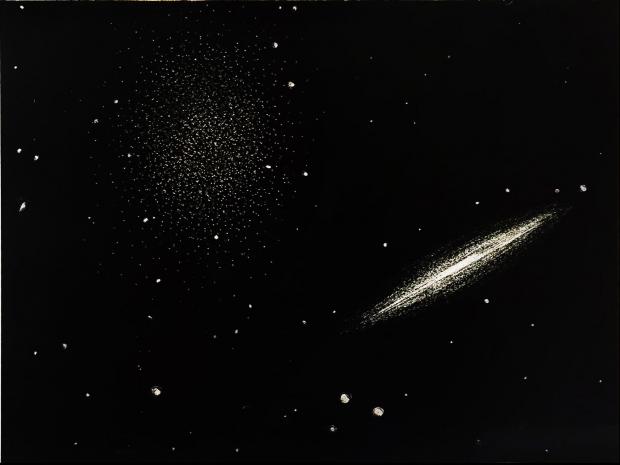Concentricity: John Dickson at Indigo Gallery
In the beginning God created the heavens and the earth. And then, being the creative sort, God looked at his work and wondered, “Is it art?” Thirteen billion years later, this Friday, Toronto-based artist John Dickson addresses the question and demonstrates that, while the universe itself may not be art, its cycles and forces make for some pretty nifty subject matter.
CONCENTRICITY is the name of Dickson’s evocative exhibition of installations and kinetic sculpture that opens this week at Indigo Gallery. There’s something of a science fair mood to the show, as the artist explores such arcane subjects as logarithmic spirals, vortices, and gravity. Instructive titles such as Molecule and M64 (Black-Eyed Galaxy) add to the teaching aid aesthetic.
This Mr. Wizard classroom vibe is nowhere more evident than in the attention-grabbing Water Spout, which if we were to split hairs, might more properly be titled Coriolis Effect. It’s comprised of a large flared cylindrical glass container filled with water that spins in a circular motion propelled by a jet. The spinning produces a continuous columnar vortex of air down its center, kind of like the tornado-shaped spout that occurs as a bathtub drains. There’s something undeniably mesmerizing about an undulating swirl, its gracefully flowing contours perpetually swaying within a seamless vitrine. Dickson presents this phenomenon with a minimalist’s eye for reductive simplicity by concealing the mechanical workings in the base. The clean appearance helps elevate Water Spout beyond mere science display.
Cloud is an approximately six-foot circular swirl of polyester batting, which hovers slightly above the floor spinning slowly. Its form is reminiscent of satellite views of hurricane systems, which from such extreme distances look like gently rotating spiral vortices. By placing the work on the floor instead of on a wall, viewers are positioned looking down on the rotating cloud formation as if from space. The twirling motion of Cloud echoes the spin of Water Spout—and something of an overarching theme begins to emerge.
The thematic link is further reinforced by Galaxies, an installation of 26 engraved plates, each depicting a spiral galaxy. A galaxy is a concentric formation on an incomprehensibly grand scale that, like hurricanes, often conforms to Jacob Bernoulli’s spira mirabilis. The individual engravings are made with small black-coated metal plates, which Dickson scratches to create the effect of star clusters in space. These are collectively mounted on the wall in a formation roughly resembling a spiral galaxy viewed from the side.

Cloud
Another kinetic work with an almost magical quality is the descriptively titled Orbits. It’s a grin-inducing sculpture comprising an unadorned square table painted black, on which a pinball-sized ball-bearing orbits mysteriously around the tabletop’s center. A smaller metal ball circles the larger one. It’s obviously based on the orbits of the earth and moon, but, with its stripped-down simplicity, it is the embodiment of the axiom less is more. Of course, to achieve such kinetic austerity, an elaborate motor and gear arrangement propels magnets under the table. But again, Dickson keeps this out of sight so as not to unnecessarily distract from the captivating orbit motion. Viewers might opt however to peek behind the curtain so to speak; the mechanism is visible under the table. Like much of the artist’s work, Orbits is equally effective as sculpture or science display.
Other works in the show include a chrome “atom” made of mirror-like steel balls, bound together with magnets, rotating on a wall-mounted platform, this time with the motor visible. Several framed works are made by spraying ink on paper. Dickson utilizes a series of stencils to build up tonal layers that create “posterized” representations of galaxies. These would pass as modernist abstractions if we could dissociate them from the many photographic images we have seen of the universe.
You could dismiss all this as bowtie wonkishness, and Dickson clearly enjoys the impenetrable pleasures of apparatus. (The kinetic sculptures in the exhibition, for instance, start up when visitors trigger a motion detector at the door.) But the artist is asking us to view the cycles and forces of nature, and the gadgets he uses to illustrate them, in a larger metaphorical context. Vortices in particular hold great significance for him. He describes them as having emotional impact, “for it is a hole into which things disappear, and can act as a metaphor for death, powerlessness, and mystery.”
As Dickson illustrates throughout, vortices often take the shape of logarithmic spirals, and each are fundamental structures of nature with their own internal order. Spirals have been a source of inspiration for artists dating back to at least the Neolithic period. They come pre-packed with emblematic meaning, and are literally hard-wired into our DNA. Mario Merz and Andy Goldsworthy have used logarithmic spirals in their work, and Robert Smithson’s Spiral Jetty derives its visual impact from the arithmetical curve. The spiral has been adopted as a symbol for pantheism, the belief that all of existence comprises an immanent god.
Vortices, too, have similarly been associated with aspects of spirituality. For Dickson, a vortex is a metaphor for our lifetime spiral toward our inevitable end, as each trip around the sun seems shorter than the last as we age. Such primal elements of nature carry with them profound significance and contemplative promise. In CONCENTRICITY, Dickson asks us to take a moment to reflect on the metaphorical significance of nature’s handiwork.

